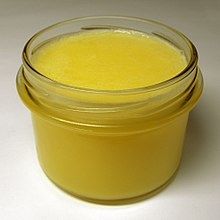Clarified butter
Clarified butter (also lard butter , clarified , boiled or refined butter , or in Switzerland fried butter ) is so-called concentrated butter obtained from butter by removing water, milk protein and milk sugar . H. Milk fat. It has similar properties to lard , but is not made from slaughter fat , but from rendered butter ( milk lard ) from cow's milk. Clarified butter is used for baking, frying and cooking. It is particularly suitable for deep-frying and frying , but is also suitable as an ingredient in fat for other preparation methods. It can be used as a butter substitute when baking.
Properties and composition
Because of its low water content, clarified butter has a much longer shelf life than butter - it can be kept for about 9 months without refrigeration and up to 15 months at refrigerator temperatures. This is why it is also used to preserve large quantities of fresh butter. Clarified butter can also be heated more strongly. The smoke point is only at 205 ° C. In relation to 100 grams, it contains 99.5 grams of fat, of which 29 percent are monounsaturated and 4.6 percent are polyunsaturated fatty acids . The rest are made up of cholesterol (278 mg), water (100 mg), fat-soluble vitamins (A: 0.93 mg, D: 1.6 µg and E: 2.4 mg) and carotene (0.53 mg).
Clarified butter is crystallized milk fat and is therefore solid at room temperature, whereas butter is a "solid emulsion " of water in liquid (or semi-crystalline) milk fat.
Manufacturing
For household production, butter is carefully heated and kept liquid for about 30 minutes without browning it. The coagulated protein settles in the foam and on the floor, and the water evaporates. The butter is clarified by skimming off the foam, then pouring it off and / or filtering it. About 700 g of pure butter fat can be obtained from 1 kg of butter.
For industrial production, butter is melted at 40 to 60 ° C and the water, milk protein and milk sugar are separated by centrifugation. In order to evaporate the last remaining water, the butterfat is heated again to about 100 ° C in the vacuum kettle. Then the clarified butter is whipped with air or nitrogen and filled.
If clarified butter is to be prepared at home as the basis for fine sauces, the butter does not have to be heated for 30 minutes. It is then sufficient to briefly heat the butter, skim off the foam that has formed, pour off the butter and leave the whey in the pan. Insofar as the terms are clarified butter and ghee not completely identical.
The production of clarified butter was subsidized by the EU for a while in order to reduce the (then) butter surplus (“ butter mountain ”). In order to prevent it from being returned to butter by emulsification, which would be tantamount to subsidy fraud, stigmasterin (required by law) had to be added to the clarified butter, which then served as an indicator . Since the "butter mountain" has not been a problem since 2008, the subsidization ended and with it the obligation to add stigmaster.
Special forms of clarified butter
Ghee
In Indian and Pakistani cuisine , ghee is one of the most important edible fats. The Indian ghee ( ) ([ gʰiː ]; Sanskrit ghṛta , n .; Hindi घी, ghī , m .; English ghee ) is produced in different processes (different in North India than in South India) and therefore also has different methods Qualities, taste characteristics and shelf life.
Nitir qibe
Also in the Ethiopian cuisine butter has - Amharic Nitir qibe ( ንጥር ቅቤ , nət'ər qəbe , often niter qibe ) on or Tigrinya tesmi called - a long tradition and is one of the characteristic of the country's cuisine ingredients.
Butter fat or butter oil
For the food industry and large bakeries , butterfat is industrially cold produced (hence no “ lard ”) and is traded worldwide as an economic good under the English name butter oil or butter fat . According to the Dr. Oetker food dictionary , its fat content must be at least 96%, while the residual water content must not exceed 0.2%. Its melting point is 42 ° C. Butterfat may contain a maximum of 0.5% free fatty acids , its shelf life is at least one year even at room temperature. The saponification number is given as 225 (range 218 to 235), the iodine number as 30 (range 25 to 38).
Individual evidence
- ↑ Jürgen Martin: The 'Ulmer Wundarznei'. Introduction - Text - Glossary on a monument to German specialist prose from the 15th century. Königshausen & Neumann, Würzburg 1991 (= Würzburg medical-historical research. Volume 52), ISBN 3-88479-801-4 (also medical dissertation Würzburg 1990), p. 151 ( milk malt : milk lard, rendered butter, synonym: butter malt ).
- ^ Clarified butter. In: German Nutrition Advice and Information Network (DEBInet). Retrieved December 30, 2013 .
- ^ Alfred Töpel: Chemistry and Physics of Milk. Natural material, raw material, food . Behr, Hamburg 2004, ISBN 3-89947-131-8 , pp. 153 ( excerpts from Google Books ).
- ↑ Dr. Oetker food dictionary. 4th edition. Oetker, Bielefeld 2004, ISBN 3-7670-0590-5 .
- ^ Hermann Pardun : Analysis of dietary fats. Paul Parey Verlag, Berlin / Hamburg 1976, ISBN 3-489-78814-1 .


